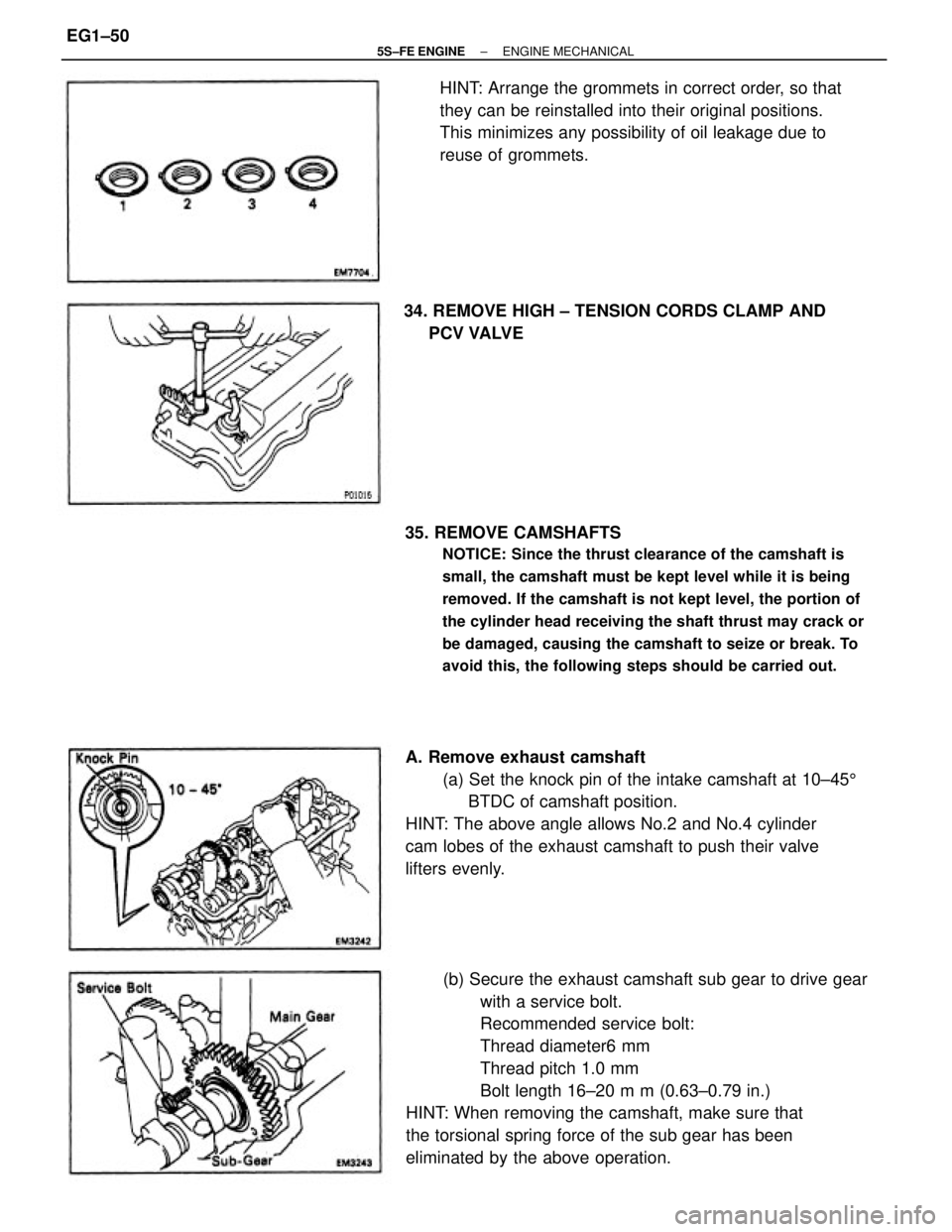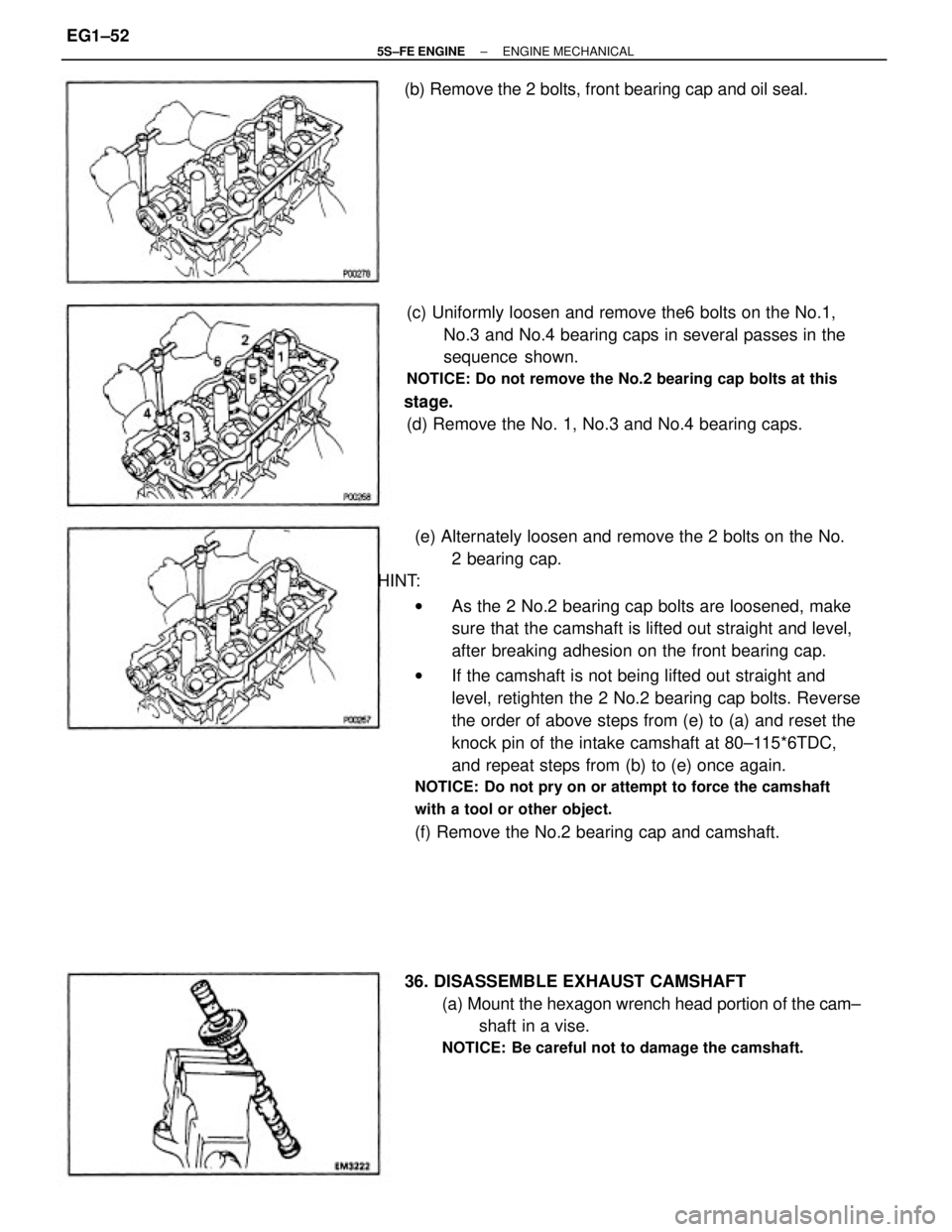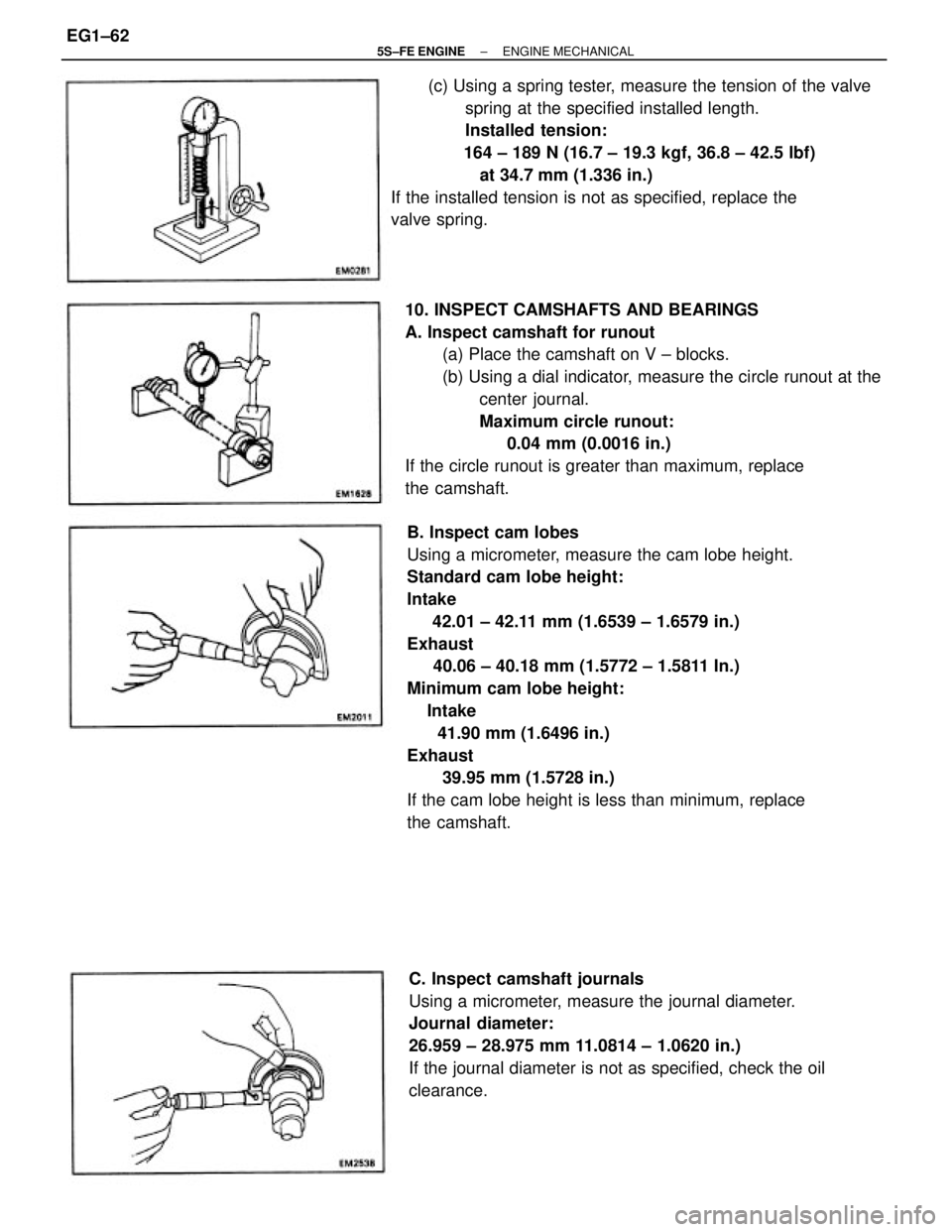Page 99 of 4770
NOTICE:
wSupport the timing belt, :o the meshing of crank±
shaft timing pulley and timing belt does not shift.
wBe careful not to drop anything inside the timing
belt cover.
wDo not allow the belt to come into correct with oil,
water or dust.
30. REMOVE ENGINE HANGERS
Remove the bolt and engine hanger. Remove the 2
engine hangers. Remove the ground strap.
31. REMOVE GENERATOR BRACKET
Remove the 3 bolts and generator bracket.
32. REMOVE OIL PRESSURE SWITCH 27. REMOVE CAMSHAFT TIMING PULLEY
(See steps 2 to 15 on pages EG1±26 to 28)
28. REMOVE NO. 1 IDLER PULLEY AND TENSION
SPRING
Remove the bolt, pulley and tension spring.
33. REMOVE CYLINDER HEAD COVER
Remove the 4 nuts, grommets, head cover and gasket.29. REMOVE NO.3 TIMING BELT COVER
Remove the 4 bolts and timing and cover.
± 5S±FE ENGINEENGINE MECHANICALEG1±49
Page 100 of 4770

(b) Secure the exhaust camshaft sub gear to drive gear
with a service bolt.
Recommended service bolt:
Thread diameter6 mm
Thread pitch 1.0 mm
Bolt length 16±20 m m (0.63±0.79 in.)
HINT: When removing the camshaft, make sure that
the torsional spring force of the sub gear has been
eliminated by the above operation. 35. REMOVE CAMSHAFTS
NOTICE: Since the thrust clearance of the camshaft is
small, the camshaft must be kept level while it is being
removed. If the camshaft is not kept level, the portion of
the cylinder head receiving the shaft thrust may crack or
be damaged, causing the camshaft to seize or break. To
avoid this, the following steps should be carried out.
A. Remove exhaust camshaft
(a) Set the knock pin of the intake camshaft at 10±455
BTDC of camshaft position.
HINT: The above angle allows No.2 and No.4 cylinder
cam lobes of the exhaust camshaft to push their valve
lifters evenly.HINT: Arrange the grommets in correct order, so that
they can be reinstalled into their original positions.
This minimizes any possibility of oil leakage due to
reuse of grommets.
34. REMOVE HIGH ± TENSION CORDS CLAMP AND
PCV VALVE
± 5S±FE ENGINEENGINE MECHANICALEG1±50
Page 102 of 4770

(e) Alternately loosen and remove the 2 bolts on the No.
2 bearing cap.
HINT:
wAs the 2 No.2 bearing cap bolts are loosened, make
sure that the camshaft is lifted out straight and level,
after breaking adhesion on the front bearing cap.
wIf the camshaft is not being lifted out straight and
level, retighten the 2 No.2 bearing cap bolts. Reverse
the order of above steps from (e) to (a) and reset the
knock pin of the intake camshaft at 80±115*6TDC,
and repeat steps from (b) to (e) once again.
NOTICE: Do not pry on or attempt to force the camshaft
with a tool or other object.
(f) Remove the No.2 bearing cap and camshaft. (c) Uniformly loosen and remove the6 bolts on the No.1,
No.3 and No.4 bearing caps in several passes in the
sequence shown.
NOTICE: Do not remove the No.2 bearing cap bolts at this
stage.
(d) Remove the No. 1, No.3 and No.4 bearing caps.
36. DISASSEMBLE EXHAUST CAMSHAFT
(a) Mount the hexagon wrench head portion of the cam±
shaft in a vise.
NOTICE: Be careful not to damage the camshaft.
(b) Remove the 2 bolts, front bearing cap and oil seal.
± 5S±FE ENGINEENGINE MECHANICALEG1±52
Page 105 of 4770
CYLINDER HEAD COMPONENTS
INSPECTION, CLEANING AND REPAIR
1. CLEAN TOP SURFACES OF PISTONS AND
CYLINDER BLOCK
(a) Turn the crankshaft, and bring each piston to top dead
center (TDC). Using a gasket scraper, remove all the
carbon from the piston top surface.
(b) Using a gasket scraper, remove all the gasket material
from the cylinder block surface.
(c) Using compressed air, blow carbon and oil from the
bolt holes.
CAUTION: Protect your eyes when using high pressure
compressed air.
2. CLEAN CYLINDER HEAD
A. Remove gasket material
Using a gasket scraper, remove all the gasket material
from the cylinder block contact surface.
NOTICE: Be careful not to scratch the cylinder block
contact surface.
B. Clean combustion chambers
Using a wire brush, remove all the carbon from the
combustion chambers.
NOTICE: Be careful not to scratch the cylinder block
contact surface.
(c) Using needle±nose pliers, remove the oil seal.
± 5S±FE ENGINEENGINE MECHANICALEG1±55
Page 107 of 4770
(c) Subtract the valve stem diameter measurement from
the guide bushing inside diameter measurement.
Standard oil clearance:
Intake
0.025 ± 0.060 mm (0.0010 ± 0.0024 in.)
Exhaust
0.030 ± 0.065 mm (0.0012 ± 0.0028 in.)
Maximum oil clearance:
Intake
0.08 mm (0.0031 in.)
Exhaust
0.10 mm (0.0039 In.)
If the clearance is greater than maximum, replace the
valve and guide bushing. (b) Using a micrometer, measure the diameter of the
valve stem.
Valve stem diameter:
Intake
5.970 ± 5.985 mm (0.2350 ± 0.2356 in.)
Exhaust
5.965 ± 5.980 mm (0.2348 ± 0.2354 In.) 5. INSPECT VALVE STEMS AND GUIDE BUSHINGS
(a) Using a caliper gauge, measure the inside diameter of
the guide bushing.
Bushing inside diameter:
6.010 ±6.030 mm (0.2366 ± 0.2374 in.) 4. CLEAN VALVES
(a) Using a gasket scraper, chip off any carbon from the
valve head.
(b) Using a wire brush, thoroughly clean the valve.
± 5S±FE ENGINEENGINE MECHANICALEG1±57
Page 112 of 4770

B. Inspect cam lobes
Using a micrometer, measure the cam lobe height.
Standard cam lobe height:
Intake
42.01 ± 42.11 mm (1.6539 ± 1.6579 in.)
Exhaust
40.06 ± 40.18 mm (1.5772 ± 1.5811 In.)
Minimum cam lobe height:
Intake
41.90 mm (1.6496 in.)
Exhaust
39.95 mm (1.5728 in.)
If the cam lobe height is less than minimum, replace
the camshaft. 10. INSPECT CAMSHAFTS AND BEARINGS
A. Inspect camshaft for runout
(a) Place the camshaft on V ± blocks.
(b) Using a dial indicator, measure the circle runout at the
center journal.
Maximum circle runout:
0.04 mm (0.0016 in.)
If the circle runout is greater than maximum, replace
the camshaft.(c) Using a spring tester, measure the tension of the valve
spring at the specified installed length.
Installed tension:
164 ± 189 N (16.7 ± 19.3 kgf, 36.8 ± 42.5 lbf)
at 34.7 mm (1.336 in.)
If the installed tension is not as specified, replace the
valve spring.
C. Inspect camshaft journals
Using a micrometer, measure the journal diameter.
Journal diameter:
26.959 ± 28.975 mm 11.0814 ± 1.0620 in.)
If the journal diameter is not as specified, check the oil
clearance.
± 5S±FE ENGINEENGINE MECHANICALEG1±62
Page 113 of 4770
E. Inspect camshaft gear spring
Using a vernier caliper, measure the free distance
between the spring ends.
Free distance:
22.5 ± 22.9 mm (0.886 ± 0.902 in.)
If the free distance is not as specified, replace the gear
spring.
F. Inspect camshaft journal oil clearance
(a) Clean the bearing caps and camshaft journals.
(b) Place the camshafts on the cylinder head.
(c) Lay a strip of Plastigage across each of the camshaft
journals. D. Inspect camshaft bearings
Check that bearings for flaking and scoring.
If the bearings are damaged, replace the bearing caps
and cylinder head as a set.
(d) Install the bearing caps.
(See step 4 on pages EG1±69 to 71)
Torque: 19 N±m (190 kgf±cm, 14 ft±lbf)
NOTICE: Do not turn the camshaft.
(e) Remove the bearing caps.
± 5S±FE ENGINEENGINE MECHANICALEG1±63
Page 114 of 4770

G. Inspect camshaft thrust clearance
(a) Install the camshaft.
(See step 4 on pages EG1±69 to 71)
(b) Using a dial indicator, measure the thrust clearance
while moving the camshaft back and forth.
Standard thrust clearance:
Intake
0.045 ± 0.100 mm (0.0018 ± 0.0039 in.)
Exhaust
0.030 ± 0.085 mm (0.0012 ± 0.0033 in.)
Maximum thrust clearance:
Intake
0.12 mm (0.0047 in.)
Exhaust
0.10 mm (0.0039 in.)
If the thrust clearance is greater than maximum, re±
place the camshaft. If necessary, replace the bearing
caps and cylinder head as a set.
H. Inspect camshaft gear backlash
(a) Install the camshafts without installing the exhaust
cam sub gear.
(See step 4 on pages EG1±69 to 71)
(b) Using a dial indicator, measure the backlash.
Standard backlash:
0.020 ± 0.200 mm (0.0008 ± 0.0079 in.)
Maximum backlash:
6.30 mm (0.0188 in.)
If the backlash is greater then maximum, replace the
camshafts. (f) Measure the Plastigage at its widest point.
Standard oil clearance:
0.025 ± 0.062 mm (0.0010 ± 0.0024 In.)
Maximum oil clearance:
0.10 mm (0.0039 in.)
If the oil clearance is greater than maximum, replace
the camshaft. If necessary, replace the bearing caps
and cylinder head as a set.
(g) Completely remove the Plastigage.
± 5S±FE ENGINEENGINE MECHANICALEG1±64